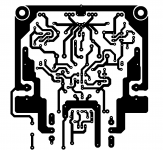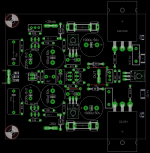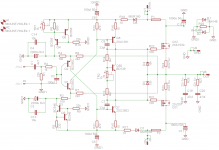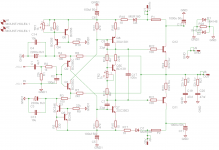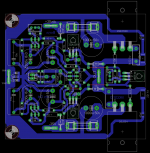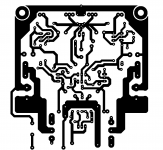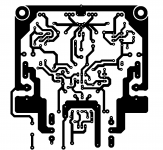Blew the Darlingtons by using it at +/- 42 V and over 350 mA bias current. Didn't really do it intentionally but happened due to a set of goofs while fiddling with the board. But it did run for quite a while in that condition ! Not bad !
The stereo board will most likely use LatFet's . I have to choose between LatFet and Bipolar. Since I need a new power amp for my new coaxial OB speaker , the LatFet would be ideal. Bass will come from a sub.
Cheers.
42V rail voltage 2X over the limit at 350mA bias. Especially with small size heatsink like yours on the picture.
Btw the BDW83C/84C can handle a bit more power.
At least you gave a try to these project.
Did you had the chance to test the amplifier with the advised semiconductors?
I mean BC550C/560C or JFet on the input, MJE243/253 for VAS.
The TIP darlington I pick to replace the BDW because cheap and available almost all store.
Using JFet instead bipolar the mis and upper area of the sound has more body, add some warmness to all over and the sound got more natural.
The MJE rock solid here since I tried many other driver like
Toshiba 2SA1930/2SC5171, 2SA968B/2SC2238B and some other from Toshiba, I'm a big Toshiba fan.
MJE150## from On Semi, also MJE240/250, BF469/470, Also BD139/140 from Philips these I blew up due to the high voltage.
The amp sounded nice with some those drivers to but to me not even came close to the MJE243/253
I didn't gave up on these little amplifier, I was busy to adopt the CCS to test here, according to LC that took his amp another league.
I made the layout for that, I will post it soon.
Btw I follow the other topic with the HEX fet, Toshiba Fet, and discrete darlington.
All the 3 mentioned type perform better some area than the well developed LC's LATfet amp. The Toshiba 2SK1530/2SJ201 and Sanken version outperform the LC amp almost every area not just in the bass even do was used cheap regular resistors, caps etc.
I do want to compare one of that version with my darlington.
I do have Toshiba fet at home also HEX fet but according to the test Sanken and Toshiba fet worth every penny in these topology even do those aren't cheap.
Now I have to remind I did tested these amplifier with discrete (built up)darlington and sounded so bad compare to the darlington I gave up any further test.
Ashok you helped me alot, now I know the amp does not oscillate, also according to you it got more stable by using that the 22R resistor.
Thank you for that.
I'm back here soon since I have the layout, I ordered some clad board already for further test.
I'll post the layout for the Toshiba and the darlington after these post.
Greetings Gabor
Hi G,
I have 2SK1530/2SJ201 also. But I don't have MJE243/253 yet. Will certainly be experimenting with this basic amp plus mods in the days to come. It looks interesting . I don't have the BC560C yet. At least I can't find my old stock but will be getting some soon.
Must thank you for bringing to our notice the performance of this circuit. Will post on significant changes when I make them. Hopefully others will try this also. It is already being worked upon on a coupe of other threads I think.
Cheers.
I have 2SK1530/2SJ201 also. But I don't have MJE243/253 yet. Will certainly be experimenting with this basic amp plus mods in the days to come. It looks interesting . I don't have the BC560C yet. At least I can't find my old stock but will be getting some soon.
Must thank you for bringing to our notice the performance of this circuit. Will post on significant changes when I make them. Hopefully others will try this also. It is already being worked upon on a coupe of other threads I think.
Cheers.
If you want to test the Toshiba mosfet here is the circuit, all do it was tested in the same circuit where the Sanken BJT was used. Since the layout was ready for the discrete darlington (Sanken or other power BJT) borys just replaced with these Toshiba
The result was excellent!
I think for these mosfet like to the LATfet and HEXfet enough a simple VAS stage so these was modified according to that.
These layout with a small change can be used for HEXfet, Darlington and for Toshiba mosfet to.
I post the layout now, there is some minor mode since the designer use 1/4W resistor.
Also I modded so I can use the power darlingtons and I hate fuse on PC boards..
The layout must be open with the paint program, print setup 34% and that is the correct size.
ashok the MJE243/253 to my darlington layout only. Here was not tested!
The result was excellent!
I think for these mosfet like to the LATfet and HEXfet enough a simple VAS stage so these was modified according to that.
These layout with a small change can be used for HEXfet, Darlington and for Toshiba mosfet to.
I post the layout now, there is some minor mode since the designer use 1/4W resistor.
Also I modded so I can use the power darlingtons and I hate fuse on PC boards..
The layout must be open with the paint program, print setup 34% and that is the correct size.
ashok the MJE243/253 to my darlington layout only. Here was not tested!
Attachments
Last edited:
I went over on the layout and found a small error which was fixed and the two smoothing capacitor was disconnected from the signal ground and connected to the right place in these case to the main ground.
Now these layout is for one pair power darlington or one pair Toshiba mosfet.
See the circuit for the difference between the two power stage.
If you use Toshiba mosfet max rail voltage 40V in Class A/B
If you use darlington like BDW83C/84C or similar power rate max rail voltage 36V at 100mA bias.
Please do not exide the rail voltage or the bias under any circumstances.
It will blow up the one pair of the mentioned darlington can not be pushed higher.
If you need more power please double the output (must be matched).
The layout need to be tested, so if you go on and build it please take the time to check the circuit before you power it up.
After with the CCS test if the result is good or better than my orig I will make layout for two pair darlington or Toshiba mosfet.
On the PC board there are no fuses be careful
be careful
Greetings Gabor
Now these layout is for one pair power darlington or one pair Toshiba mosfet.
See the circuit for the difference between the two power stage.
If you use Toshiba mosfet max rail voltage 40V in Class A/B
If you use darlington like BDW83C/84C or similar power rate max rail voltage 36V at 100mA bias.
Please do not exide the rail voltage or the bias under any circumstances.
It will blow up the one pair of the mentioned darlington can not be pushed higher.
If you need more power please double the output (must be matched).
The layout need to be tested, so if you go on and build it please take the time to check the circuit before you power it up.
After with the CCS test if the result is good or better than my orig I will make layout for two pair darlington or Toshiba mosfet.
On the PC board there are no fuses
Greetings Gabor
Attachments
Last edited:
I'm still on holiday but visited some local parts dealers ( in Colombo). I got two pairs of 2SA1216 and 2SC2922. That's all he had ! Couldn't find any other devices we normally use except 2sc1845 and 2sa992.
Has anyone used the 1216/2992 in this circuit ? Need to determine what supply voltage I can use.
Has anyone used the 1216/2992 in this circuit ? Need to determine what supply voltage I can use.
In a similar topology those Sankens was tested, they perform very well and sound gooood  according to Marc.
according to Marc.
All do these circuit has CCS (have a feeling you not after that) with the discrete darlington at 40V 100mA very stable.
Take a look at here
http://www.diyaudio.com/forums/solid-state/237219-fet-hex-explendit-amplifier-39.html
I will have to test and compare with my old darlington amp to know more about these circuit.
These circuit similar but still a lot differ from mine.
Feedback, capacitor values, transistors, other resistor values etc.
You can see all that.
The good think you can use the transistors from these circuit if you do not want any CCS.
Greetings Gabor
All do these circuit has CCS (have a feeling you not after that) with the discrete darlington at 40V 100mA very stable.
Take a look at here
http://www.diyaudio.com/forums/solid-state/237219-fet-hex-explendit-amplifier-39.html
I will have to test and compare with my old darlington amp to know more about these circuit.
These circuit similar but still a lot differ from mine.
Feedback, capacitor values, transistors, other resistor values etc.
You can see all that.
The good think you can use the transistors from these circuit if you do not want any CCS.
Greetings Gabor
Has anyone considered the NTE253MCP? Matched pair of power darlingtons.
$4.59 a pair here
NTE253MCP NTE253MCP pdf NTE253MCP datasheet NTE NTE253MCP NTE253MCP 4.59 American Microsemiconductor NTE253MCP available at 4.59. FREE UPS ground shipping or more.
$4.59 a pair here
NTE253MCP NTE253MCP pdf NTE253MCP datasheet NTE NTE253MCP NTE253MCP 4.59 American Microsemiconductor NTE253MCP available at 4.59. FREE UPS ground shipping or more.
Thanks Gabor for your Email
Some one know how using SANKEN STD03 darlington with thermaltrack and remoce the VBE multiplier ?
http://www.diyaudio.com/forums/atta...-diy-amplifier-20-years-go-bg1-daelington.png
Thanks
Some one know how using SANKEN STD03 darlington with thermaltrack and remoce the VBE multiplier ?
http://www.diyaudio.com/forums/atta...-diy-amplifier-20-years-go-bg1-daelington.png
Thanks
I've just got back and have to go out of town again ! Going to pick up a used tube amp !
So my plans with the "20 year old amp design" has been stalled further.
I'm attracted towards the LatFet version especially as the mid and HF was the way I liked it. It is also inherently stable. I just want to squeeze out more power from it , at least 100W/8 ohms and 200W into 4 ohms. There are various ways of implementing this. So much to try and so little time and also budget constraints!
Does anyone know if the 2SC1815/2SA1015 sound as good as the BC550C/BC560C . I don't know how this might be possible with all the circuit feedback etc, but one never knows, someone might have compared them !
So my plans with the "20 year old amp design" has been stalled further.
I'm attracted towards the LatFet version especially as the mid and HF was the way I liked it. It is also inherently stable. I just want to squeeze out more power from it , at least 100W/8 ohms and 200W into 4 ohms. There are various ways of implementing this. So much to try and so little time and also budget constraints!
Does anyone know if the 2SC1815/2SA1015 sound as good as the BC550C/BC560C . I don't know how this might be possible with all the circuit feedback etc, but one never knows, someone might have compared them !
Today I pick up a Sony receiver which has 4 pair Sanken MP1620/MN2488 darlington transistors.
I didn't tested yet these amp, I hope at least one pair work so I can test these amplifier with those Sanken darlingtons.
Very likely those transistors are orig Sankens, I don't think Sony use counterfeit semiconductors or other parts.
They are more rugged (on [paper) than the TIP types, in case if they work in circuit I can do some comparison.
Greetings G
I didn't tested yet these amp, I hope at least one pair work so I can test these amplifier with those Sanken darlingtons.
Very likely those transistors are orig Sankens, I don't think Sony use counterfeit semiconductors or other parts.
They are more rugged (on [paper) than the TIP types, in case if they work in circuit I can do some comparison.
Greetings G
#10
linuxguru
diyAudio Member
Join Date: Sep 2007
Yes, they're sonically very good, especially for darlingtons. They're very fast and have reasonable SOA. Darlingtons in a Class-AB/B Emitter Follower have a relatively small Vbe-biasing sweet spot, and Sony apparently uses a carefully-controlled Sziklai Vbe multiplier with a hi-beta (>1000) master to achieve this. The rest of the stuff is usually in a monolithic analog LSI.
I'm not sure if they'll sound just as good in an all-discrete implementation without careful optimization, but at the time they were manufactured for Sony, it was probably a very optimal value-engineered design choice. The alternatives like the TIP142/147 sound much worse in similar topologies.
That what I found on the forum, sometimes good to have other people opinion to.
Greetings G
linuxguru
diyAudio Member
Join Date: Sep 2007
Yes, they're sonically very good, especially for darlingtons. They're very fast and have reasonable SOA. Darlingtons in a Class-AB/B Emitter Follower have a relatively small Vbe-biasing sweet spot, and Sony apparently uses a carefully-controlled Sziklai Vbe multiplier with a hi-beta (>1000) master to achieve this. The rest of the stuff is usually in a monolithic analog LSI.
I'm not sure if they'll sound just as good in an all-discrete implementation without careful optimization, but at the time they were manufactured for Sony, it was probably a very optimal value-engineered design choice. The alternatives like the TIP142/147 sound much worse in similar topologies.
That what I found on the forum, sometimes good to have other people opinion to.
Greetings G
Hi G,
I just got an old tube power amp. I must say that it's mid range and HF are in a different league compared to the 20 year old design and other amps like the Creek 5350 etc. It must have much poorer distortion specs on paper but it certainly sounds more life like ! It conveys the energy of the cymbals much better than all ss amps that I have access too ( including the Bryston 2b and 4B). Voice has a texture (!) that's hard to beat !
But wait. My Lat Fet stereo amp is being built. Will try again after that and see what differences are left!
I just got an old tube power amp. I must say that it's mid range and HF are in a different league compared to the 20 year old design and other amps like the Creek 5350 etc. It must have much poorer distortion specs on paper but it certainly sounds more life like ! It conveys the energy of the cymbals much better than all ss amps that I have access too ( including the Bryston 2b and 4B). Voice has a texture (!) that's hard to beat !
But wait. My Lat Fet stereo amp is being built. Will try again after that and see what differences are left!
Member
Joined 2009
Paid Member
.....I find I like to design and play with SS nonetheless........
Right !

Thanks Acca. Yes this is certainly worth trying. If I refined it , it would have another 20 resistors and other components!
The PSRR is also not great as it is. But it certainly is very simple to give it a go.
My experience has been that an input stage with cleaner supply is audibly superior to the same circuit without a filtered supply to the input stage. Maybe here it doesn't matter ?
But I will try out this basic circuit. It will be interesting to see how it sounds as it is.
The PSRR is also not great as it is. But it certainly is very simple to give it a go.
My experience has been that an input stage with cleaner supply is audibly superior to the same circuit without a filtered supply to the input stage. Maybe here it doesn't matter ?
But I will try out this basic circuit. It will be interesting to see how it sounds as it is.
- Home
- Amplifiers
- Solid State
- My first DIY amplifier 20 years a go
